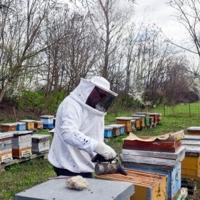Magda Miloseska puts on a white protective suit every day and tends to the honeybees in her backyard in North Macedonia. She has been producing honey in this beautiful part of the country for over 20 years, but she notes that climate change and diseases have made it more challenging.
Stence, a village in the west of the country, where Miloseska resides, is facing higher temperatures due to climate change, making beekeeping more difficult. The number of beekeepers has increased in recent years, but the European Commission warns that bees and butterflies are threatened with extinction in Europe.
– Honey production down –
Older beekeepers remember times when they could produce 30-50 kilograms of honey from one beehive, but now, due to climate conditions, this has significantly decreased. The changes in climate have also led to a rise in prices and a decrease in honey production.
Beekeepers like Vladimir Petroski are adapting to the challenges by educating themselves and adjusting to the changing conditions. They are working together through regional beekeepers’ associations to promote good practices and find solutions to protect the bees.
– Educate and adapt –
Environmental groups are urging government ministries to coordinate efforts to address the impact of climate change on bees. More data and collaboration between state institutions are essential to mitigate the threats bees are facing.
The United Nations Environmental Programme emphasizes the crucial role bees play in food production and biodiversity, highlighting the urgent need to protect these pollinators for the future of agriculture.
dd/jj





